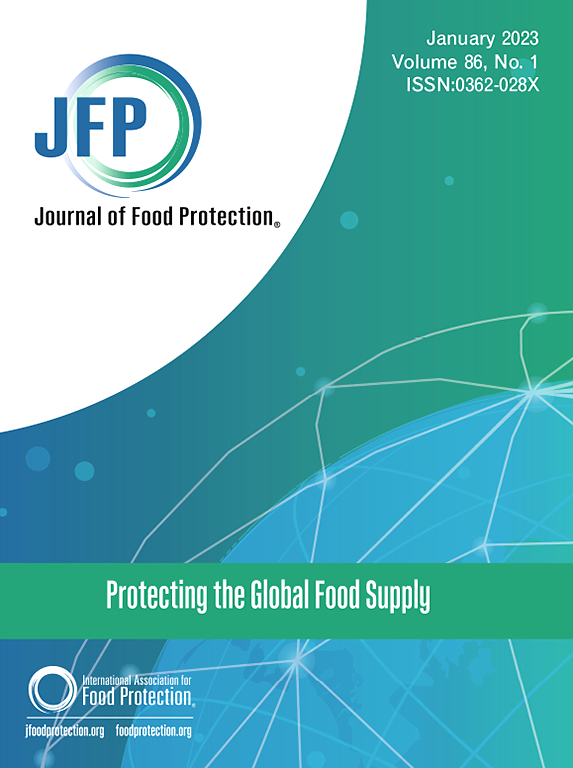大肠杆菌从地膜向大田番茄和甜椒转移的定量研究。
IF 2.1
4区 农林科学
Q3 BIOTECHNOLOGY & APPLIED MICROBIOLOGY
引用次数: 0
摘要
在美国,食品和药物管理局(USFDA)禁止销售在收获期间从植物上掉落并接触地面的水果。这包括附着在植物上时接触地面的果实,称为“下垂”果实。在美国东南部,番茄和辣椒是用棚架种植的,种植在塑料覆盖物上。本研究的目的是获得非致病性大肠杆菌绿色荧光蛋白接种在塑料地膜(黑色和白色)上到水果(西红柿和辣椒)上的细菌转移率,这些水果在美国佐治亚州的夏季通过落在(30、60或120厘米的高度)或下垂(接触时间为1小时或24小时)的方式接触地面。在地膜表面接种大肠杆菌(106 CFU/64 cm2),干燥后减少2 ~ 3 log CFU/64 cm2。一旦接种物干燥,果实要么通过PVC管从不同的高度掉落,要么放回其最初的休息位置。大肠杆菌从地膜转移到掉落番茄和辣椒果实的平均对数百分比为-2.00 ~ 0.46(0.01% ~ 2.88%)。大肠杆菌向下垂果实转移的平均对数百分比在-0.83 ~ 0.01(0.15% ~ 1.02%)之间,不同地膜颜色和接触时间处理的作物类型间转移无显著差异。整个实验过程中的现场环境条件,如环境空气温度、相对湿度、UVAB辐射强度和塑料表面温度,都可能影响细菌转移率。虽然其他研究已经在实验室环境中评估了细菌的存活和从地膜到水果的转移,但本研究解决了水果接触地膜时在田间下垂和掉落事件中细菌转移的知识空白,提供的结果有可能为未来的农产品收获和处理提供监管指导。本文章由计算机程序翻译,如有差异,请以英文原文为准。
Quantification of Escherichia coli Transfer from Plastic Mulch to Field-grown Tomatoes and Bell Peppers
In the United States, the Food and Drug Administration (USFDA) prohibits the distribution of fruit that is dropped from the plant and contacts the ground during harvest. This includes fruit which contacts the ground while attached to the plant, called “drooping” fruit. In the Southeastern US, tomato and pepper are trellised and grown on plastic mulch. The objective of this study was to obtain bacterial transfer rates from a nonpathogenic Escherichia coli GFP inoculated on plastic mulch (black and white) to fruit (tomatoes and peppers) that contact the ground by being dropped (at heights of 30, 60, or 120 cm) or by drooping (contact times of 1 h or 24 h) in the field during the summer season in Georgia, USA. Plastic mulch was surface inoculated with E. coli (106 CFU/64 cm2), and after drying, populations were reduced by >2–3 log CFU/64 cm2. Once inoculum was dry, the fruit was either dropped from different heights through a PVC pipe or placed back onto the mulch in its initial resting place. The mean log percent transfer of E. coli from plastic mulch to dropped tomato and pepper fruit was −2.00 to 0.46 (0.01–2.88%). Mean log percent transfer rates of E. coli to drooping fruit were between −0.83 and 0.01 (0.15–1.02%), with no significant differences in transfer within crop types between treatments of plastic mulch color or contact time. Field environmental conditions throughout the experiment such as ambient air temperature, relative humidity, UVAB radiation intensity, and surface temperature of plastic likely affected the rates of bacterial transfer. While other studies have evaluated bacterial survival and transfer from mulch to fruit in a laboratory setting, the present study addresses knowledge gaps in bacterial transfer during drooping and dropping incidents in the field when fruit contacts plastic mulch, providing results that have potential to inform future regulatory guidance for produce harvest and handling.
求助全文
通过发布文献求助,成功后即可免费获取论文全文。
去求助
来源期刊

Journal of food protection
工程技术-生物工程与应用微生物
CiteScore
4.20
自引率
5.00%
发文量
296
审稿时长
2.5 months
期刊介绍:
The Journal of Food Protection® (JFP) is an international, monthly scientific journal in the English language published by the International Association for Food Protection (IAFP). JFP publishes research and review articles on all aspects of food protection and safety. Major emphases of JFP are placed on studies dealing with:
Tracking, detecting (including traditional, molecular, and real-time), inactivating, and controlling food-related hazards, including microorganisms (including antibiotic resistance), microbial (mycotoxins, seafood toxins) and non-microbial toxins (heavy metals, pesticides, veterinary drug residues, migrants from food packaging, and processing contaminants), allergens and pests (insects, rodents) in human food, pet food and animal feed throughout the food chain;
Microbiological food quality and traditional/novel methods to assay microbiological food quality;
Prevention of food-related hazards and food spoilage through food preservatives and thermal/non-thermal processes, including process validation;
Food fermentations and food-related probiotics;
Safe food handling practices during pre-harvest, harvest, post-harvest, distribution and consumption, including food safety education for retailers, foodservice, and consumers;
Risk assessments for food-related hazards;
Economic impact of food-related hazards, foodborne illness, food loss, food spoilage, and adulterated foods;
Food fraud, food authentication, food defense, and foodborne disease outbreak investigations.
 求助内容:
求助内容: 应助结果提醒方式:
应助结果提醒方式:


